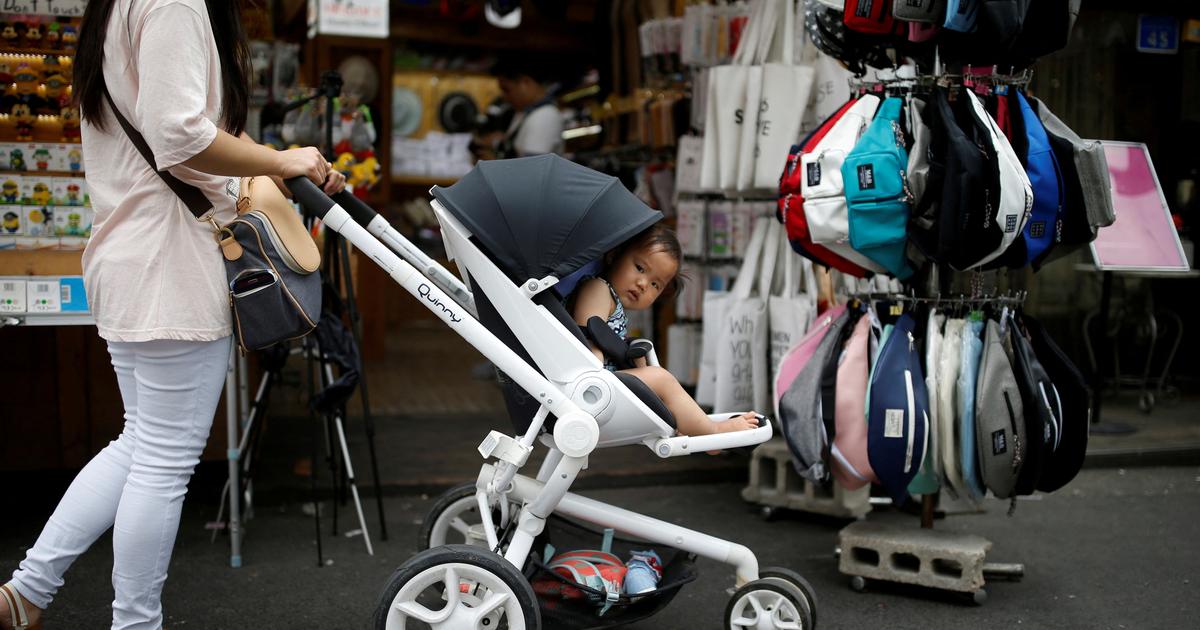A mother with her newborn in February at the Vall d'Hebron Maternal and Child Hospital in Barcelona.Carles Ribas / EL PAÍS
Nine months later, the omens of the experts are fulfilled.
Births in December and January fell 22.6% compared to the same months of the previous year.
The pandemic has plummeted the birth rate in Spain.
It is not yet the definitive data, but it constitutes the first indicator of the effects of the confinement of March and April, when the children born in December and January were conceived.
In those months, 45,054 babies were registered as a result of those days when the country was locked up at home, according to information from 3,929 computerized civil registries, corresponding to 93% of the population.
There are 13,141 fewer children.
The decline will sink fertility in a country that has suffered years of declines.
You have fewer and fewer children and you have them later.
And now, with the uncertainty in which the virus has plunged us, the situation is expected to worsen.
How much?
Even when?
Nobody dares to predict it, but they do venture that it will not be a crisis of a few months.
The problem is that it rains when it is wet.
The 360,617 births in 2019 were the lowest figure in the entire historical series of the National Institute of Statistics, which begins in 1941, a record that also reached the first half of 2020. These figures are explained because right now there are fewer generations of women of age to be mothers and because the moment of having the first child is gradually delayed.
But to this we must now add the social and psychological consequences of a pandemic.
Hospitals such as Vall d'Hebron or Sant Pau, in Barcelona, attended 10% fewer new pregnancies in 2020 and deliveries have decreased at the same rate during January and February 2021. At Hospital La Paz, in Madrid, they were registered in 2020 up to 14% fewer consultations from the first three months of pregnancy.
There are centers that do not perceive a change in trend because the fall in the birth rate had already been registered previously.
As is the case at the Miguel Servet Hospital, in Zaragoza, where the head of Obstetrics, Sergio Castán, speaks of a decrease of “5% per year” that was previously observed, or the Virgen del Rocío Hospital, in Seville, whose director of the maternal-fetal unit, Guillermo Antiñolo, figures a 40% reduction in deliveries attended in 12 years: from 9,000 in 2008 to just over 5,000 in 2020.
The data confirm that there is a new phenomenon to that of a progressive fall in the birth rate.
Just last January, the first full month in which the consequences of confinement can be calibrated, 6,889 fewer babies were registered in the civil registry than in the same month of 2020. The difference is notable because in January 2020, 511 fewer children were registered than that month of 2019. If the fall from 2019 to 2020 was 1.7%, that of now, 23%.
There is the pandemic.
From 'viejenials' to 'viejunos': the demographic challenge flies over the pandemic
The great drop in students that is already changing the school
This is how Spain has changed since the first censuses of the 18th century
"It will be the INE who will give the real figure, but the data agrees with what we expected and what we are seeing in other countries," explains Diego Ramiro, director of the Institute of Economy, Geography and Demography of the Higher Council for Scientific Research (CSIC) .
In December, the reduction in Italy was 21.6%.
In January, births fell in France by 13%.
"In some states of the United States such as Florida, California or Hawaii, there have been falls of 5% to almost 20%," he adds.
March and April were the blackest months of the pandemic, the first time citizens were ordered to lock themselves at home.
In those days, the streets were emptied and the dead numbered in the hundreds.
On March 30 alone, 913 people lost their lives.
Virtually everything stopped.
In a month and a half, almost a million jobs were destroyed.
At that time the horizon of the vaccine was not even in sight.
Normal life disappeared and, amid financial difficulties, doubts about the future or health, many decided to delay the decision to start a family.
Ramiro believes that the decline will strongly affect those conceived then and in May, the hardest months of confinement.
“We can hope that after the state of alarm subsided, more children would be conceived.
But when the second wave returns, there will probably be another delay, and so on with the third wave.
It is not convenient to extrapolate the data from the two months of confinement to the rest of the year, but the fall is expected to be strong ”.
The 1918 flu
In terms of the drop in fertility, the effects of the pandemic are not comparable to what happened in the Civil War, the moment in recent history with the greatest collapse in the numbers, says Ramiro.
Alberto Sanz, professor at the Faculty of Political Sciences and Sociology of the Complutense University of Madrid, explains that then the transfer of men to the front, death and subsequent misery and purges broke the fertility rate, but that generation had another opportunity to have children since the age to form a family was very early.
And even after the 1918 Spanish flu pandemic, the recovery was "fast": it was not common to use contraception and sexual practices were not unrelated to reproduction.
But this time, Ramiro does not expect a rebound when the storm passes: “Apart from the epidemic crisis, we will have an economic crisis and we have already seen the effects of 2008, which has caused a sustained decline.
Now we are entering a year of hiatus and we will have the lowest fertility levels ever in Spain ”.
We are still immersed in the embers of that economic crisis.
Alberto Sanz explains that "it left us with the lowest level of fertility, which went from 1.4 to 1.2 children per woman [one of the lowest in the world]."
The problem is not that there are few children, but the difference with the desired motherhood: the majority of the population would like to have two children.
The panorama left by the covid complicates the situation.
For Albert Esteve, director of the Center for Demographic Studies at the Autonomous University of Barcelona, the point is that in a country where “the average age of first-time mothers is 32 years, if the pandemic delays the decision for another two years, the fertility will be more complicated, and the option of having a second child even more ”.
It is likely that there are families that do not get to have that second child and that couples grow up without children.
Teresa Castro, a CSIC demographer, speaks of a host of factors behind this fall.
A kind of perfect storm that can be summed up in four words: job and life uncertainty.
“A survey conducted in March and April by Italian researchers revealed that a high percentage of those who wanted to have children in the next 12 months had delayed or abandoned their plans.
In Spain, half said they would postpone it and 29% that they gave up, "he says.
“The biggest factor is job uncertainty.
Even if you do not lose your job, you are afraid of losing it and decide to wait, as unemployment and temporary employment are expected to increase.
But the young adult generation caught by the 2008 crisis has already delayed vital transitions such as emancipation, starting a family.
We have not yet come back from that crisis and now this crisis is coming ”, he says.
Albert Esteve agrees with this reasoning.
“Strengthening family conciliation and paternity leave is useful, but the most important thing to increase fertility is to facilitate young people to become emancipated earlier.
It cannot be that half of the 30-year-olds have not been emancipated ”, he indicates.
It also points out that the fall will also be influenced by the fact that migratory flows have stopped short, and that it is women of foreign origin who have the highest fertility rates (1.59 children per woman, compared to 1.17 for Spanish women) .
And that the statistics will be affected by the postponement of assisted reproductive pregnancies.
Assisted reproduction
These treatments were stopped during confinement and the public health waiting list may have increased by 50%, according to the experience of Elisa Llurba, director of the Gynecology and Obstetrics service at Hospital Sant Pau, a center where from 10% to 15% of pregnancies are with assisted reproduction.
The specialist maintains that precariousness is pushing future mothers to give up private treatments to enroll on public waiting lists.
A process that takes a long time that many do not have.
“The pandemic generates, on the one hand, alert and, on the other, uncertainty.
And we make decisions according to the level of certainty ”, says Miguel Hierro, professor of Psychology at the Autonomous University of Madrid.
Avoid generalizations and note that probably a 38-year-old couple feels that they have less room to wait than a 23-year-old and it may cost them more to delay the decision.
But he explains that this uncertainty that has invaded everything for a year now is also related to the well-being that is wanted for the children: "If I understand that the pandemic can affect upbringing and their development, I can postpone having them."
Albert Esteve believes that 2022, when the conceived are born this year, could be even worse.
There may be a fourth wave.
And it will be seen that the crisis has further limited the emancipation capacity of young people, he explains.
It all depends on the evolution of the economy in the coming years.
But a recovery in V of fertility is not expected, says Diego Ramiro.
The forecasts are not good in the near future.
There is a birth crisis for a while.
Information about the coronavirus
- Here you can follow the last hour on the evolution of the pandemic
- Restrictions search engine: What can I do in my municipality?
- This is how the coronavirus curve evolves in the world
- Download the tracking application for Spain
- Guide to action against the disease















/cloudfront-eu-central-1.images.arcpublishing.com/prisa/IGZ7GOCXZ5GUPAQ2HWGK6Z76BU.jpg)